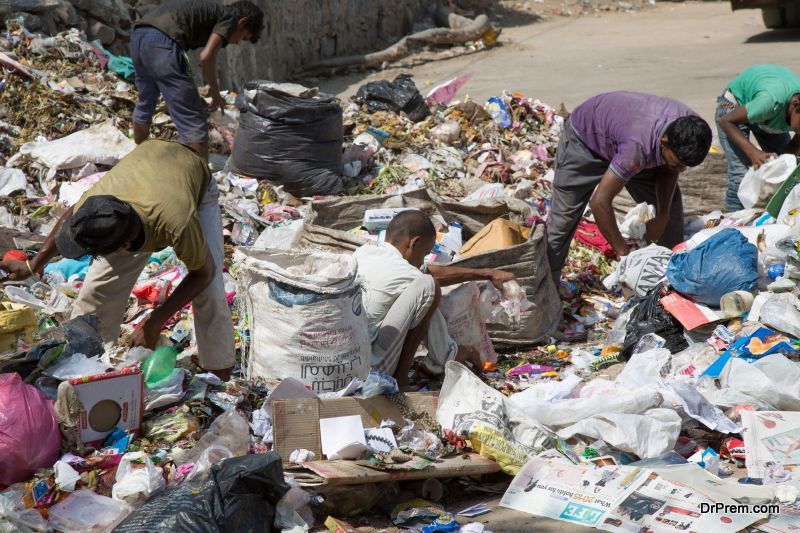Garbage has been a problem for eons. In the past, we just threw it out the window… literally covering the streets with our filth, trash, and dirt. This system worked when there was a lot of land and few people, but when populations and cities grew, the garbage problem grew as well. In the more recent past (from the 1920s to the 1970s), instead of throwing trash out of the window, people have taken it to the garbage dump, which is basically a big hole in the ground where trash is buried… also not a great long-term solution for the environment. In 1976, the U.S. Congress passed the Resource Conservation and Recovery Act and fundamentally changed how we store and process our garbage.
 Cities and governments are striving to be more environmentally friendly when it comes to managing their trash and waste. Since 1993, federal regulations have required alternative daily covers (ADCs; also called landfill cap covers or rain covers) in an effort to improve health and safety around landfills. ADCs are what cover the landfills to maintain sanitary conditions and prevent vermin and disease. Whereas garbage dumps were simply holes in the ground, landfills are now required to be engineered, carefully planned, and closely monitored to be more environmentally safe and efficient. Engineers and city planners must now look into the long-term effects before designating an area as a landfill; garbage dumps are no longer allowed for health, safety, and environmental reasons.
Cities and governments are striving to be more environmentally friendly when it comes to managing their trash and waste. Since 1993, federal regulations have required alternative daily covers (ADCs; also called landfill cap covers or rain covers) in an effort to improve health and safety around landfills. ADCs are what cover the landfills to maintain sanitary conditions and prevent vermin and disease. Whereas garbage dumps were simply holes in the ground, landfills are now required to be engineered, carefully planned, and closely monitored to be more environmentally safe and efficient. Engineers and city planners must now look into the long-term effects before designating an area as a landfill; garbage dumps are no longer allowed for health, safety, and environmental reasons.
A landfill must also be carefully planned and engineered to isolate the trash from the surrounding environment such as the groundwater supply. This is accomplished by using a bottom liner as well as a daily covering of soil or clay. Engineers and scientists know that the long-term consequences of dumping large amounts of garbage in one place could be catastrophic, and so they are working toward better environmental solutions to the trash problem.The EPA has been instrumental in creating regulations for landfill design and use, requiring the following layers for every landfill:
- a layer of soil
- a layer of a geotextile such as a synthetic permeable membrane that filters out the trash from the water
- a leachate (water) collection system
- a plastic liner layer to prevent leachate from reaching the groundwater
- an impermeable clay layer to stop any water that makes it through the plastic layer
- special capping systems that close off the landfill from leaking harmful gasses into the air.
The geotextile layer is instrumental for the successful filtering and function of a landfill. A geosynthetic membrane cover such as those manufactured by Western Liner can be crucial to controlling odor and dust, minimizing windblown litter, discouraging pests and vermin, shedding surface water more quickly, and improving the overall appearance and function of the landfill. They are easy to install and tear resistant. They can also be manufactured in one solid piece depending on size, thus reducing the probability of tears and punctures.
Another way that the federal government is trying to make landfills safer for the environment is by keeping track of the trends in recycling, composting, and energy generation from waste processes and applying that knowledge to city and state landfilling. The latest data are from 2014, but the United States alone generated almost 260 million tons of municipal solid waste (MSW) that year.
With its greater emphasis on recycling and composting, the FDA is striving to reduce our total amount of solid waste generated through landfills. The EPA has been building on the familiar catchphrase “Reduce, Reuse, Recycle” and trying to move beyond just recycling and landfilling.
With our present-day scientific advances and passionate commitment to preserving the environment, our laws and rules can only improve the country’s landfills and their structures. While the government sets federal rules and regulations to require our landfills and waste management systems to be as progressive as possible, we must continue to strive to do all that we can to protect our planet and Reduce, Reuse, Recycle, and Reimagine a better way to manage our resources from the beginning to the end.
Article Submitted By Community Writer



